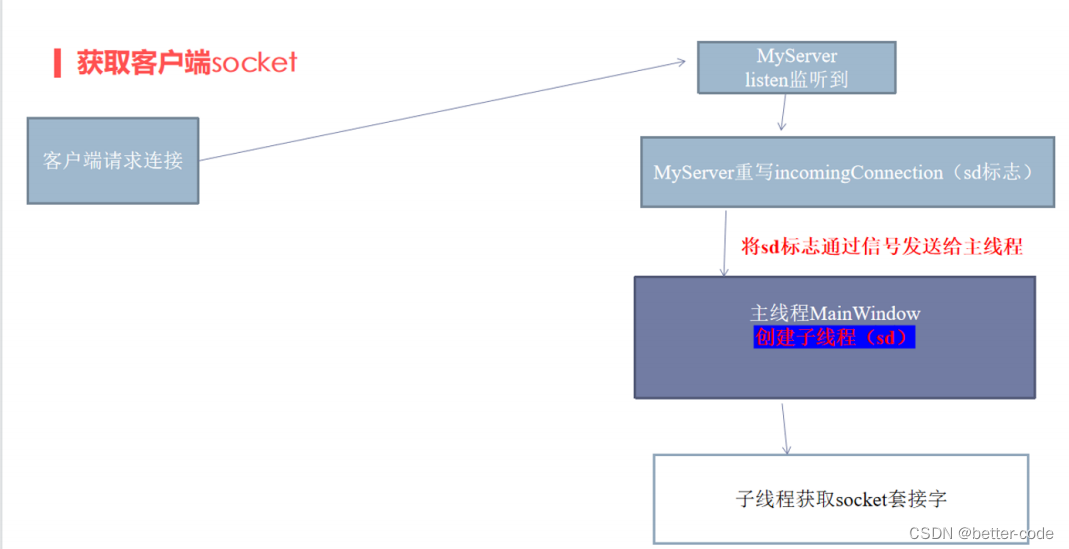C++ —— AVL树
- AVL树的概念
- AVL树节点的定义
- AVL树的插入
- 向上调整
- 旋转
- 左单旋
- 右单旋
- 左右双旋
- 右左双旋
- AVL树的高度
- AVL树的验证
- 总结:
- 代码
AVL树的概念
二叉搜索树虽可以缩短查找的效率,但如果数据有序或接近有序二叉搜索树将退化为单支树,查找元素相当于在顺序表中搜索元素,效率低下。因此,两位俄罗斯的数学家G.M.Adelson-Velskii和E.M.Landis在1962年发明了一种解决上述问题的方法: 当向二叉搜索树中插入新结点后,如果能保 证每个结点的左右子树高度之差的绝对值不超过1(需要对树中的结点进行调整) 即可降低树的高度,从而减少平均搜索长度。
AVL树本质上是一颗二叉查找树,但是它又具有以下特点:
- 它的左右子树都是AVL树
- 左右子树高度之差(简称平衡因子)的绝对值不超过1 即(-1 / 0 / 1)。
在AVL树中,任何节点的两个子树的高度最大差别为 1 ,所以它也被称为平衡二叉树.
如果一棵二叉搜索树是高度平衡的,它就是AVL树。如果它有n个结点,其高度可保持在 o ( l o g 2 n ) o(log_2 n) o(log2n),搜素时间复杂度o( l o g 2 n log_2 n log2n)。

本文规定:
平衡因子时采用公式:平衡因子 = 右子树高度 - 左子树高度
AVL树节点的定义
template<class K,class V>
struct AVLTreeNode
{
AVLTreeNode<K, V>* _left;
AVLTreeNode<K, V>* _right;
AVLTreeNode<K, V>* _parent;
pair<K, V> _kv;
int _bf; //存储当前节点的平衡因子
//构造函数
AVLTreeNode(const pair<K, V>& kv)
:_left(nullptr)
,_right(nullptr)
,_parent(nullptr)
,_kv(kv)
,_bf(0)
{}
};
这里使用了pair来存储节点的值,_bf表示改节点的平衡因子。
AVL树的插入
AVL树的插入步骤大致分为下面两种
- 找到准备插入节点的位置
- 更新节点的平衡因子
- 做出相应的调整
看下面几个实例:


因为新插入的节点会影响到树原本的平衡,所以每次插入都得更新节点的平衡因子,平衡因子的变化有以下几种:
- 首先按照搜索树的规则插入
- 更新插入节点的祖先节点的平衡因子
- 插入父亲的左边,父亲平衡因子
- - - 插入父亲的右边,父亲平衡因子
+ +
- 插入父亲的左边,父亲平衡因子
- 根据父亲的平衡因子分以下三种调整:
- 父亲平衡因子是 0 , 父亲所在子树的高度不变,稳定,不需要向上更新。
- 父亲平衡因子是 1 / -1 ,父亲所在子树的高度变了,继续向上更新直到稳定。
- 父亲平衡因子是 2 / -2 ,父亲所在子树已经不平衡了,需要旋转处理。

向上调整
while (parent)
{
if (cur == parent->_left)
{
parent->_bf--;
}
else
{
parent->_bf++;
}
if (parent->_bf == 0)
//已经平衡,无需调整,结束。
{
break;
}
else if (parent->_bf == 1 || parent->_bf == -1)
// 0 -> 1 / -1 需要线上调整
{
cur = parent;
parent = cur->_parent;
}
else if (parent->_bf == 2 || parent->_bf == -2)
//1 / -1 -> 2 -2 需要旋转
{
//旋转
}
}
旋转
AVL树的旋转分为两种:单旋 和 双旋
其中单旋转又分为:右单旋(RotateR) 和 左单旋(RotateL)
其中双旋转又分为:右左双旋(RotateRL) 和 左右双旋(RotateLR)
为什么会有多旋呢?
因为有些情况单旋无法解决,不得不选择双旋,具体情况下文将继续讨论。
左单旋
假设我们有下图AVL树:

现在需要插入新节点15,插入后如图:

但因为此时节点13的平衡因子为2,不稳定,需要旋转处理,如下图:

由结果可知,将节点13进行左旋转,让节点13的父亲变为节点14,节点14的左孩子变为节点13,节点14的父亲变为节点12,即可达到平衡。
动图演示:

代码:
void RotateL(Node* parent)
{
Node* SubR = parent->_right;
Node* SubRL = SubR->_left;
parent->_right = SubRL;
if (SubRL)
{
SubRL->_parent = parent;
}
Node* ppNode = parent->_parent;
SubR->_left = parent;
parent->_parent = SubR;
if (parent == _root)
{
_root = SubR;
SubR->_parent = nullptr;
}
else
{
if (ppNode->_left == parent)
{
ppNode->_left = SubR;
}
else
{
ppNode->_right = SubR;
}
SubR->_parent = ppNode;
}
parent->_bf = SubR->_bf = 0;
}
右单旋
假设我们有下图AVL树:

现在需要插入新节点3,插入后如图:

但因为此时节点5的平衡因子为**-2**,不稳定,需要旋转处理,如下图:

由结果可知,将节点5进行右旋转,让节点5的父亲变为节点4,节点4的右孩子变为节点5,节点4的父亲变为节点10,即可达到平衡。
动图演示:

void RotateR(Node* parent)
{
Node* SubL = parent->_left;
Node* SubLR = SubL->_right;
parent->_left = SubLR;
if (SubLR)
{
SubLR->_parent = parent;
}
Node* ppNode = parent->_parent;
SubL->_right = parent;
parent->_parent = SubL;
if (parent == _root)
{
_root = SubL;
SubL->_parent = nullptr;
}
else
{
if (ppNode->_left == parent)
{
ppNode->_left = SubL;
}
else
{
ppNode->_right = SubL;
}
SubL->_parent = ppNode;
}
parent->_bf = SubL->_bf = 0;
}
左右双旋
假设我们有下图AVL树:

现在需要插入新节点7,插入后如图:

但因为此时节点10的平衡因子为 -2 节点4的平衡因子是1 ,不稳定,需要先进行左旋处理,如下图:

左旋完成后,此时节点10的平衡因子仍为 -2 不稳定,再进行右单旋,如下图:

由结果可知,经过节点4的左旋处理,再经过节点10的右旋处理,最终平衡。
动图演示:

由上述的上述调整代码可知,因为节点10的平衡因子是-2,所以在进行左右双旋时,节点10是parent,我们定义 节点5为SubL,节点4为SubLR。分别对SubL和parent进行左单旋和右单旋。
但是上述是吧新添加的节点插入到了5的右边,实际上共有下面三中情况可以引起树的双旋转:
1. 插入在较高左子树的右侧的左边
2. 插入在较高左子树的右侧的右边
3. 直接当作较高左子树的右边
插入在较高左子树的右侧的左边:

2. 插入在较高左子树的右侧的右边

3. 直接当作较高左子树的右边

所以由上面三种情况 ,我们可以总结出最终的平衡因子调整规则:
- 当
subLR = 0时:调整为subLR = 0 ,subL = 0 ,parent= 0 - 当
subLR =-1时:调整为subLR =0 ,subL = 0 ,parent = 1 - 当
subLR = 1时:调整为subLR = 0 ,subL =-1,parent = 0
代码:
void RotateLR(Node* parent)
{
Node* SubL = parent->_left;
Node* SubLR = SubL->_right;
int bf = SubLR->_bf;
RotateL(SubL);x
RotateR(parent);
if (bf == -1)
{
SubLR->_bf = 0;
SubL->_bf = 0;
parent->_bf = 1;
}
else if (bf == 1)
{
SubLR->_bf = 0;
SubL->_bf = -1;
parent->_bf = 0;
}
else if (bf == 0)
{
SubLR->_bf = 0;
SubL->_bf = 0;
parent->_bf = 0;
}
else
{
assert(false);
}
}
右左双旋
由左右双旋的推理我们可以得出: 当将新添加的节点插入到较高右子树的左侧使需要右左双旋。
具体分为三种情况:
1. 插入在较高右子树的左侧的右边
2. 插入在较高右子树的左侧的左边
3. 直接当作较高右子树的左边
1. 插入在较高右子树的左侧的右边

2. 插入在较高右子树的左侧的左边

3. 直接当作较高右子树的左边

代码:
void RotateRL(Node* parent)
{
Node* SubR = parent->_right;
Node* SubRL = SubR->_left;
int bf = SubRL->_bf;
RotateR(SubR);
RotateL(parent);
SubRL->_bf = 0;
if (bf == 1)
{
SubRL->_bf = 0;
parent->_bf = -1;
SubR->_bf = 0;
}
else if (bf == -1)
{
SubRL->_bf = 0;
parent->_bf = 0;
SubR->_bf = 1;
}
else
{
SubRL->_bf = 0;
parent->_bf = 0;
SubR->_bf = 0;
}
}
AVL树的高度
int _Height(Node* root)
{
if (root == nullptr)
return 0;
return max(_Height(root->_left), _Height(root->_right)) + 1;
}
AVL树的验证
bool _IsBalance(Node* root)
{
if (root == nullptr)
return true;
int leftHeight = _Height(root->_left);
int rightHeight = _Height(root->_right);
// 不平衡
if (abs(leftHeight - rightHeight) >= 2)
{
cout << root->_kv.first << endl;
return false;
}
// 顺便检查一下平衡因子是否正确
if (rightHeight - leftHeight != root->_bf)
{
cout << root->_kv.first << endl;
return false;
}
return _IsBalance(root->_left)
&& _IsBalance(root->_right);
}
总结:

代码
#pragma once
#include <assert.h>
#include <vector>
#include <iostream>
using namespace std;
template<class K,class V>
struct AVLTreeNode
{
AVLTreeNode<K, V>* _left;
AVLTreeNode<K, V>* _right;
AVLTreeNode<K, V>* _parent;
pair<K, V> _kv;
int _bf; //存储当前节点的平衡因子
//构造函数
AVLTreeNode(const pair<K, V>& kv)
:_left(nullptr)
,_right(nullptr)
,_parent(nullptr)
,_kv(kv)
,_bf(0)
{}
};
template<class K, class V>
class AVLTree
{
typedef AVLTreeNode<K, V> Node;
public :
bool Insert(const pair<K, V>& kv)
{
if (_root == nullptr)
{
_root = new Node(kv);
return true;
}
Node* parent = nullptr;
Node* cur = _root;
while (cur)
{
if (kv.first > cur->_kv.first)
{
parent = cur;
cur = cur->_right;
}
else if (kv.first < cur->_kv.first)
{
parent = cur;
cur = cur->_left;
}
else
{
return false;
}
}
cur = new Node(kv);
if (parent->_kv.first < kv.first)
{
parent->_right = cur;
}
else
{
parent->_left = cur;
}
cur->_parent = parent;
//更新平衡因子
while (parent)
{
if (cur == parent->_left)
{
parent->_bf--;
}
else
{
parent->_bf++;
}
if (parent->_bf == 0) //已经平衡,无需调整,结束。
{
break;
}
else if (parent->_bf == 1 || parent->_bf == -1) // 0 -> 1 / -1 需要线上调整
{
cur = parent;
parent = cur->_parent;
}
else if (parent->_bf == 2 || parent->_bf == -2) //1 / -1 -> 2 -2
{
//当前树已经出现了问题,需要旋转
if (parent->_bf == -2 && cur->_bf == -1)
{
RotateR(parent);
}
else if (parent->_bf == 2 && cur->_bf == 1)
{
RotateL(parent);
}
else if (parent->_bf == 2 && cur->_bf == -1)
{
RotateRL(parent);
}
else if (parent->_bf == -2 && cur->_bf == 1)
{
RotateLR(parent);
}
break;
}
else
{
//不会出现的情况
assert(false);
}
}
return true;
}
Node* Find(const K& key)
{
Node* cur = _root;
while (cur)
{
if (key > cur->_kv.first)
{
cur = cur->_right;
}
else if (key < cur->_kv.first)
{
cur = cur->_left;
}
else
{
return cur;
}
}
return nullptr;
}
void RotateR(Node* parent)
{
Node* SubL = parent->_left;
Node* SubLR = SubL->_right;
parent->_left = SubLR;
if (SubLR)
{
SubLR->_parent = parent;
}
Node* ppNode = parent->_parent;
SubL->_right = parent;
parent->_parent = SubL;
if (parent == _root)
{
_root = SubL;
SubL->_parent = nullptr;
}
else
{
if (ppNode->_left == parent)
{
ppNode->_left = SubL;
}
else
{
ppNode->_right = SubL;
}
SubL->_parent = ppNode;
}
parent->_bf = SubL->_bf = 0;
}
void RotateL(Node* parent)
{
Node* SubR = parent->_right;
Node* SubRL = SubR->_left;
parent->_right = SubRL;
if (SubRL)
{
SubRL->_parent = parent;
}
Node* ppNode = parent->_parent;
SubR->_left = parent;
parent->_parent = SubR;
if (parent == _root)
{
_root = SubR;
SubR->_parent = nullptr;
}
else
{
if (ppNode->_left == parent)
{
ppNode->_left = SubR;
}
else
{
ppNode->_right = SubR;
}
SubR->_parent = ppNode;
}
parent->_bf = SubR->_bf = 0;
}
void RotateRL(Node* parent)
{
Node* SubR = parent->_right;
Node* SubRL = SubR->_left;
int bf = SubRL->_bf;
RotateR(SubR);
RotateL(parent);
SubRL->_bf = 0;
if (bf == 1)
{
SubRL->_bf = 0;
parent->_bf = -1;
SubR->_bf = 0;
}
else if (bf == -1)
{
SubRL->_bf = 0;
parent->_bf = 0;
SubR->_bf = 1;
}
else
{
SubRL->_bf = 0;
parent->_bf = 0;
SubR->_bf = 0;
}
}
void RotateLR(Node* parent)
{
Node* SubL = parent->_left;
Node* SubLR = SubL->_right;
int bf = SubLR->_bf;
RotateL(SubL);x
RotateR(parent);
if (bf == -1)
{
SubLR->_bf = 0;
SubL->_bf = 0;
parent->_bf = 1;
}
else if (bf == 1)
{
SubLR->_bf = 0;
SubL->_bf = -1;
parent->_bf = 0;
}
else if (bf == 0)
{
SubLR->_bf = 0;
SubL->_bf = 0;
parent->_bf = 0;
}
else
{
assert(false);
}
}
bool IsBalance()
{
return _IsBalance(_root);
}
int Height()
{
return _Height(_root);
}
int Size()
{
return _Size(_root);
}
void InOrder()
{
_InOrder(_root);
cout << endl;
}
private:
int _Size(Node* root)
{
return root == nullptr ? 0 : _Size(root->_left) + _Size(root->_right) + 1;
}
int _Height(Node* root)
{
if (root == nullptr)
return 0;
return max(_Height(root->_left), _Height(root->_right)) + 1;
}
bool _IsBalance(Node* root)
{
if (root == nullptr)
return true;
int leftHeight = _Height(root->_left);
int rightHeight = _Height(root->_right);
// 不平衡
if (abs(leftHeight - rightHeight) >= 2)
{
cout << root->_kv.first << endl;
return false;
}
// 顺便检查一下平衡因子是否正确
if (rightHeight - leftHeight != root->_bf)
{
cout << root->_kv.first << endl;
return false;
}
return _IsBalance(root->_left)
&& _IsBalance(root->_right);
}
void _InOrder(Node* root)
{
if (root == nullptr)
{
return;
}
_InOrder(root->_left);
cout << root->_kv.first << ":" << root->_kv.second << endl;
_InOrder(root->_right);
}
Node* _root = nullptr;
};
void TestAVLTree1()
{
//int a[] = { 8, 3, 1, 10, 6, 4, 7, 14, 13 };
int a[] = { 4, 2, 6, 1, 3, 5, 15, 7, 16, 14 };
AVLTree<int, int> t1;
for (auto e : a)
{
/*if (e == 4)
{
int i = 0;
}*/
// 1、先看是插入谁导致出现的问题
// 2、打条件断点,画出插入前的树
// 3、单步跟踪,对比图一一分析细节原因
t1.Insert({ e,e });
cout << "Insert:" << e << "->" << t1.IsBalance() << endl;
}
t1.InOrder();
cout << t1.IsBalance() << endl;
}
void TestAVLTree2()
{
const int N = 100000;
vector<int> v;
v.reserve(N);
srand(time(0));
for (size_t i = 0; i < N; i++)
{
v.push_back(rand() + i);
//cout << v.back() << endl;
}
size_t begin2 = clock();
AVLTree<int, int> t;
for (auto e : v)
{
t.Insert(make_pair(e, e));
//cout << "Insert:" << e << "->" << t.IsBalance() << endl;
}
size_t end2 = clock();
cout << "Insert:" << end2 - begin2 << endl;
//cout << t.IsBalance() << endl;
cout << "Height:" << t.Height() << endl;
cout << "Size:" << t.Size() << endl;
size_t begin1 = clock();
// 确定在的值
for (auto e : v)
{
t.Find(e);
}
// 随机值
/*for (size_t i = 0; i < N; i++)
{
t.Find((rand() + i));
}*/
size_t end1 = clock();
cout << "Find:" << end1 - begin1 << endl;
}


















